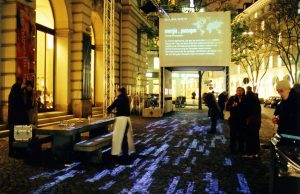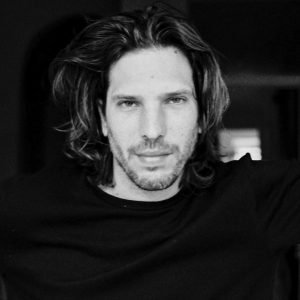
Photo credit: Stefanie Seidl
Monika Fleischmann & Wolfgang Strauss
Title: New Media Art – A Thinking Space for Digitality?
Bio:
Monika Fleischmann (*1950 in Karlsruhe) and Wolfgang Strauss (*1951 near Nuremberg) are the German artist and scientist duo, who have been working with digital media as a combination of art and technology since the mid-1980s, with a focus on mixed reality.
After training as a fashion designer in Zurich, Monika Fleischmann studied fine arts and drama at the Berlin University of the Arts. After completing an apprenticeship as a carpenter, Wolfgang Strauss studied architecture at the Berlin University of the Arts. They immersed themselves in the Berlin subculture during the 70s, the time of the new wild painting, the new German wave music, the new feminist movement and the coming out of gays and lesbians. They celebrated the Berlin legendary club scene – Dschungel, So36, Shizzo, Berlin Bar – danced with Martin Kippenberger or listened to the music of Rio Reiser.
In 1987, they founded ARTWORK, the studio for art and architecture, and at the same time, together with Edouard Bannwart, established the ART+COM Institute for interdisciplinary research, development and design of new media in urban space. From 1997, they continued working together under the acronym MARS (Media Arts Research Studies) at GMD and Fraunhofer research institutions in the field of art and computer-mediated communication as a new cultural technique and artistic-scientific basic research, with a focus on visualization, sonification and interface.
Their pioneering work began with “Berlin-Cyber City” (1989), which shows Berlin after the fall of the Berlin Wall, in its memorable history and in a possible future. Working with maps of the city as part of the research project “New Media in Urban Space” was the impetus for further ART+COM projects, that led to the dispute with Google Earth depicted (not entirely accurate) in the Netflix series “The Billion Dollar Code.” Another seminal work was “Semantic Map” (2001-04), a further development of neural networks and a method of data analysis now standard in AI in general and the NSA in particular. In “Home of the Brain” (1989-1991), Fleischmann and Strauss enable the audience to walk through „Philosophers’ houses“, the minds of others with the help of Virtual Reality goggles and data glove. “Liquid Views” (1992), the mirror of media narcissism, anticipated the selfie generation and is regarded an iconic work and one of the masterpieces of media art. Digital information flows are active artificial agents, in digital, physical and social processes in the interactive works of Fleischmann & Strauss.
They anticipated the new interactive media as carriers and structurer of information and the power of images as media of our perception of the world. With their internationally exhibited interactive productions, Fleischmann and Strauss have made history in virtual reality and interactive media art and are considered pioneers of media art. With the topic of the „Virtual Denkraum“ and from the perspective of the empowerment of people in the face of monopolies, they cite the changes that have occurred with the development of technologies, of social inequality and economic related issues that have become increasingly important. In this realm they see the interface – the “performative interface” – as a fundamental tool, and as in real life as a way to new knowledge through interactivity, a realm where the users can act, collaborate with other users, can explore new meanings and create its own.
Fleischmann and Strauss have received numerous awards, including the Golden Nica of Ars Electronica (1992), the SIGGRAPH Lifetime Achievement Award in Digital Art (2018) and were honored by being accepted into the SIGGRAPH Academy (2018).
Abstract:

Energy-Passages (2004), (c) Monika Fleischmann & Wolfgang Strauss
Today, we often don’t know who owns the houses we live in. There is so much secrecy – whether for tax or speculative reasons, and the political caste supports this. This may have to do with corruption or ignorance, and from this lack of transparency, perhaps leaks and hacks can help. It turns out that the concept of knowledge has changed. In Germany, a transparency register on property and ownership – in Excel format – is now to be created. Actually, the information hidden here would have to be uncovered forensically with the help of AI and documented in a blockchain for data security reasons.
Based on their works since the mid-1980s, the artists show the changed conditions of knowledge in digital culture. It is no longer only the knowledge of details that counts, but life takes place in an environment of nodes of networked knowledge. Connected to this is the need to acquire the ability to draw one’s own conclusions from this networked knowledge – and thus to practice neuroaesthetics as a complement to AI: A knowledge space based on performative interfaces. Whereby we have to ask ourselves whether humans can still think when everything is automated? The media artworks of Fleischmann & Strauss show walk-in knowledge spaces for the construction or emergence of a neural aesthetic, which differ from the common VR and AR concepts.

Rudolfo Quintas; photo credits by Aya Koretzky
Rudolfo Quintas
Title: “Can I Hear You Dance?” and Eco-Acoustic Embodiment
RESUME:
A discussion about the relationship between the philosophical, technological and art practice research towards the flourishing of new concepts and audience experience.
Bio:
Rudolfo Quintas (Porto,1980) is a Portuguese media artist creating data mapping installations, paintings, sculptures and performances using interactive, generative and artificial intelligence techniques. In a continuous dialogue between philosophy, science and technology Quintas’ work often brings the invisible to new forms of perception through simple elements like air, fire, body movement or cell biology to discuss invisible systems of power and control in the social, political and psychological domains.
Quintas has a deep interest in decolonizing body language and corporal behaviour, frequently designing algorithmic and computer based installations that involve cognitive feedback processes for the self-exploration of the audience. This research is presented in artworks such as Displacement (2004), Absorption (2014), Black Hole (2018), among other performative works such as Swap (2005), Burning the Sound (2007) or Darkless (2016). Described by curator Verónica Metello as ‘Sensitive-Contexts”. In the past years, Quintas took these feedback processes to a greater scale by portraying society in data paintings and installation that speculate the relation between infodemic and mental health with News Feed (2019), KEYSTONE-I-II-III-IV (2019), Portugal In The Clouds (2021).
This body of work has earned national and international distinctions by the way of grants, artistic residences, scholarships and art prizes such as the DGartes/ Portuguese Ministry of Culture and the Transmediale Distinction Award at the Transmediale festival in Berlin. The work is published in Performance Research (Routledge), research papers as NIME – New Interfaces for Musical Expression, and art editions such as the “Younger Than Jesus: Artist Directory” co-edited by New Museum New York and Phaidon Press among others.
Quintas work was shown his galleries, cultural venues and art festivals, such as the Transmediale/CTM festival (Berlin), Todays Art festival (The Hague), Dox Gallery and the ENTER festival (Prague), Fundació “La Caixa ” (Barcelona), La Casa Encendida (Madrid), STEIM (Amsterdam), the “Uncharted” exhibition at Santralistanbul (Istanbul), Pixelache festival at Kiasma museum (Helsinki), NIME (Sydney) or the Royal College of Art in London. In Portugal, Quintas has recently presented his work in Sónar Festival, the Index of Art and Technology festival in Braga, FOCO gallery in Lisbon, the Convento de São Francisco cultural center in Coimbra, the Criatek festival in Aveiro and the MNAC – National Museum of Contemporary Art Chiado. Quintas lives and works in Lisbon.
Abstract:

“Can I Hear You Dance?” ; photo credits by Bruno Lopes
Rudolfo Quintas will share how in his creative process, the philosophical, technological and studio practice research, structure the development of new concepts, inspire the visual and aural composition of his artworks and discuss the place of artistic experience as a form of knowledge. Also his studio expansion of digital art into new social and inclusive narratives.
These ideas will be discussed by observing the creative process of “Can I Hear You Dance ?” one of his recent audiovisual installations. The research aimed for an intimate and inclusive relationship between human beings and nature and it was developed through the concept of Eco-acoustic Embodiment that consists in the creation and apprehension of sounds produced by body expression in the environment.
Eco-acoustic Embodiment arises from the junction of two concepts, that of Acoustic Ecology or Ecoacoustics – which determines the discipline that studies the relationship, mediated through sound, between human beings and their environment (Böhme, Gernot – 2000) and Embodiment, which focuses on the observation of knowledge through the physical experience of the body, as opposed to knowledge transmitted through oral or written language.
Quintas investigation proposes a discussion on how the contemporary body, constantly mediated by technology, can reinvent and expand its bond with nature. Could this experience of sound embodiment help to restore the intimacy that we have been losing with the natural environment? Quintas rehearses this concept, inviting two blind people to an immersion in nature where attention is paid to the experience that arises from mutual causality, to the dialogue established through listening and movement.

